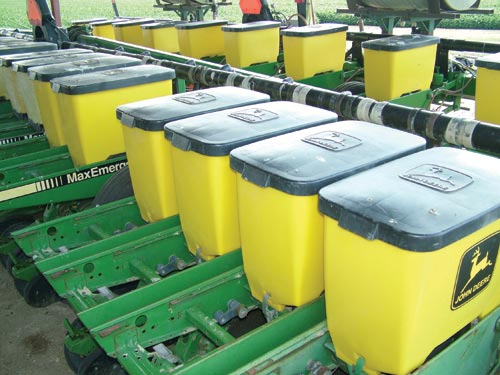
Three years ago, soybean and corn producers Toney Lensing and Raymond Harris decided they needed to go back to bedding up ground on their farm just north of Lake Providence, La. But they didn’t want to spend a lot of money getting there.
The producers had been planting their soybeans flat, but didn’t like what they were seeing. “It normally took a long time to run water across the field,” Lensing said. “And if we watered and it rained behind that, we’d scald them. That’s why we wanted to get bedded up.”
To help them get there, they purchased two John Deere 8330 tractors with Auto-Steer and a customized One Trip Plow from KBH Corporation. The plow is 30 feet wide and builds five, 72-inch rows, with a 54-inch planting surface.
They saw one of the customized plows in action on the farm of Bob Manning, who farms around Waterproof, La. Manning planted winter wheat on wide beds, then followed up with a narrow-row soybean crop.
“We’re old cotton farmers, and we believe in planting on beds,” Lensing said. “The plow has gotten us back to planting on beds. It’s also given us the advantages of planting narrow row soybeans. We could have done something with twin-row soybeans, but we didn’t like the expense of a twin-row planter.”
Instead, Lensing and Harris built their own planter from two used John Deere planters. It plants four rows of narrow-row soybeans 15 inches to 16 inches apart on top of a 54-inch row created by the plow. They purchased a new corn planter to plant two rows of corn on the beds.
“A lot of times, you can only get these narrow spacings on soybeans on flat ground. But with this, you have both worlds,” Lensing said. “You can plant more rows of beans, but you still have your furrow and your bed and your drainage.”
The plow runs right behind the combine in the fall and eliminates a shredding operation, according to Tommy Condrey, president of Mod-Track, who customized the plow for Lensing and Harris. In one pass through the field it breaks the land, cuts the root of the existing crop, while incorporating organic matter into the seed bed area, and then beds it back up. A chisel plow shank runs in the middle of the wide bed followed by an 18-inch sweep which provides additional lifting and breaking of the soil.
A 6-row plow weighs about 8,500 pounds, which could make a 10-row rig a little intimidating. “But you don’t really have to lift the plow,” Condrey says. “You just set it down and pull it.” The plow was originally designed for cotton but has successfully been used in corn, soybeans, milo and other crops.
A traditional One Trip Plow would have 11 busters, but the customized wide-row version runs only five, which Condrey says saves about 15 horsepower per buster.
Lensing and Harris have seen their average season-long fuel cost for fieldwork drop from nearly 16,000 gallons per season to 9,000 gallons with the combination of the 8330 tractors and making fewer trips across the field.
The wide beds have also improved irrigation efficiency and have almost eliminated the risk of scalding beans for Lensing and Harris, who are 60 percent to 70 percent irrigated. They furrow irrigate their heavy land and depend on rainfall for their sandy loam soils.
They water down every row in the wide-row configuration, which is equivalent to watering every other row in 36-inch soybeans, which also helps conserve water. “The beds seem to water faster, and it doesn’t seem to waterlog the beds,” Lensing said. The middle rows get plenty of water and show no signs of height differential, Lensing notes. “The water soaks across the bed.”
In corn, Lensing says the wide beds can help keep fertilizer where it belongs. The producers knife in 240 units of nitrogen placed on top of the bed in between the two corn rows. Lensing says nitrogen can be lost if it’s placed close to the water furrow, as on 36-inch spacings, especially if there are heavy rains. “We’re not saving fertilizer costs; we’re saving fertilizer, because we’re not putting it down the furrows.”
In the fall, Lensing and Harris follow the combine with the plow. Depending on the crop and the soil condition, they may run it twice. “If this ground is hard, it’s going to chunk it up,” Lensing said. “When we get a rain on it, we like to come back with the plow again and freshen it back up. In corn, after we plow the first time, we’re going to get corn coming up. So when we freshen the beds, it gets rid of that corn, and it leaves us a nice clean bed. Sometimes on bean ground, we just need to run it once.”
This is third year Lensing and Harris have been using wide-row beds. The producers believe the wide beds will cut costs and eventually will demonstrate higher yields. It’s hard to tell if there’s been a yield bump from the wide beds with the excessive rainfall during the last two harvest seasons. No doubt, the wide row system and multi-function plow has cut fuel and water costs.
“We wanted to get everything on a bed because it drains and waters better. Preparing our land with the wide row allows more flexibility for any style planting operation in the spring,” Lensing said. “That led us to here.”
e-mail: [email protected]
About the Author(s)
You May Also Like






